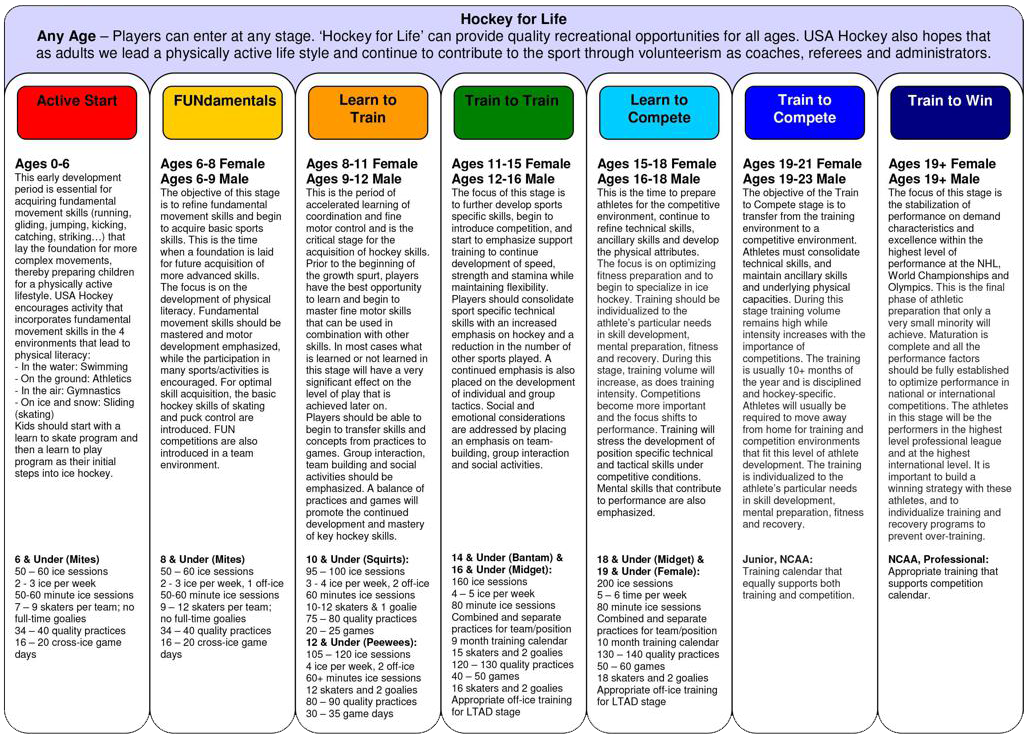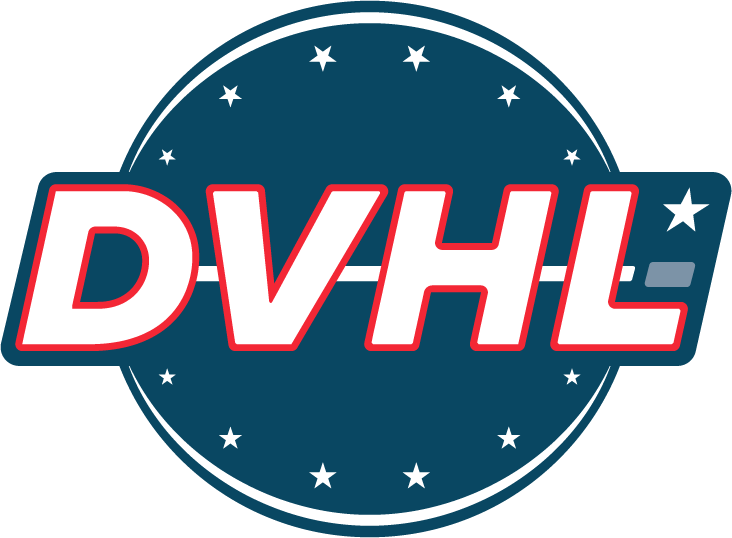Ladder of Development — Player Development
The Athlete Development Model (ADM) is built on the principles of long-term athlete development (LTAD), a framework developed by the internationally renowned coach educator, Istvan Balyi. These principles serve as a guide to enhance the consistency of our existing systems and structures. USA Hockey has adapted these principles to ice hockey, and they are deeply rooted in successful programs worldwide.
When USA Hockey began this project, one of the first things they did was to closely examine the statistics related to player development –specifically the skill development time each player has in both a practice setting and a game setting. When viewed from the perspective of how kids learn, the number of repetitions of specific skills and situations that occur in practice versus a game is where players can develop the most: in practice.
The ADM model prioritizes practice and proper training, but it’s not just about the technical aspects. It’s about making practices enjoyable and engaging without taking the fun out of hockey. When kids play together and have fun with a game they love, it’s not just fun — it’s a key part of their development. By combining this passion for the game with increased puck time, kids will start to excel at it. Play, Love, Excel. That’s the ADM, a holistic approach that balances fun and development.
1. ACTIVE START — AGES 0-6
This early development period is essential for acquiring fundamental movement, and begins to acquire basic sports skills (running, gliding, jumping, kicking, catching, striking, etc.) that form the foundation for more complex movements, thereby preparing children for a physically active lifestyle. USA Hockey encourages activity that incorporates fundamental movement skills in the four environments that lead to physical literacy: in the water (swimming), on the ground (athletics), in the air (gymnastics), on ice and snow (sliding and skating). Kids should start with a learn- to-skate program and then a learn-to-play program as their initial steps into hockey.
2. FUNDAMENTALS — AGES 6-8 (FEMALE) AGES 6-9 (MALE)
The objective of this stage is to refine fundamental movement skills and begin acquiring basic sport skills through fun-focused methods. This is the time when a foundation is set for future acquisition of more advanced skills. In this stage, the focus is on the development of physical literacy. Fundamental movement skills are continually developed through a variety of activities and participation in other sports beyond hockey. For hockey development, the basics of skating and puck control are the focus. Fun competitions are also introduced in a team environment.
3. LEARN TO TRAIN — AGES 8-11 (FEMALE) AGES 9-12 (MALE)
This is the period during which learning of coordination and fine motor control occurs. Players in this development stage should begin transferring concepts from practice to games. Group interaction, team building, and social activities should be emphasized. A wise ratio of practices and games (3 to 1) will promote efficient development and mastery of hockey skills.
4. TRAIN TO TRAIN — AGES 11-15 (FEMALE) AGES 12-16 (MALE)
The focus of this stage is to further develop sports-specific skills, begin to introduce competition, and continue emphasizing support training to continue development of agility, speed, power and strength. Players should consolidate sports-specific technical ability with an increased emphasis on hockey and a reduction in the number of other sports played. A continued emphasis is also placed on the development of individual and group tactics. Social and emotional considerations are addressed by placing an emphasis on team building, group interactions and social activities.
5. LEARN TO COMPETE — AGES 15-18 (FEMALE) AGES 16-18 (MALE)
This is the time to prepare athletes for the competitive environment, continue to refine technical and ancillary skills, and develop the physical attributes. The focus is on optimizing fitness preparation and beginning to specialize in hockey. Training should be individualized to the athlete’s particular needs in skill development, mental preparation, fitness and recovery. During this stage, training volume and intensity increases. Competitions become more important and the focus shifts to learning the requirements of performance. Training emphasizes the development of position-specific technical and tactical skills under competitive conditions. Mental skills that contribute to performance are also emphasized.
6. TRAIN TO COMPETE — AGES 19-21 (FEMALE) AGES 19-23 (MALE)
The objective of this stage is to transfer from the training environment to a competitive environment. Athletes must consolidate technical skills and maintain ancillary skills and underlying physical capabilities. Training volume remains high while intensity increases with the importance of competitions. Training is usually 10+ months of the year, disciplined and hockey specific. Athletes will usually be required to move away from home for training and competition environments that fit this stage of development.
7. TRAIN TO WIN — AGES 19+
The focus of this stage is the stabilization of performance-on-demand characteristics and achieving excellence at the highest levels of performance, e.g., professional hockey, the Olympics, the World Championship. Only a very small percentage will achieve this stage. It is important to build a winning strategy with these athletes and to individualize training and recovery to prevent over-training.
8. HOCKEY FOR LIFE — ALL AGES
Players can enter this stage at any age, as “Hockey for Life” can provide quality recreational opportunities for all ages. Whether as a “rink-rat” at a local outdoor rink, as an intramural/ club hockey player at a college or university, or in adult recreational leagues, USA Hockey believes that the opportunity to play and have fun should be available to all players with various levels of commitment. Even later in life, USA Hockey hopes that everyone leads a physically active, healthy lifestyle that includes the great game of hockey. Studies have shown that physical exercise can increase the rate at which the brain creates new brain cells. It makes an old brain act more like a young one in its ability to generate neurons needed for learning and remembering new things. So, in effect, exercise helps the brain stay youthful.

Content courtesy of USA Hockey’s “Parent HANDBOOK”

